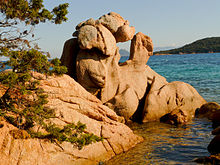Rosa Sardo

With Rosa Sardo are granites from the Italian granite Gallura region which have in the Massif Limbara in the North of Sardinia be dismantled. The granite types are quarried in numerous quarries , especially around Tempio Pausania in the province of Sassari , but also to a lesser extent in other places. The extremely large natural stone deposit originated in the Carboniferous 330 million years ago.
Names
The granites of the Limbara massif, which are quarried in more than a dozen quarries, are marketed under different names. Numerous trade names are often known with the omission of Sardo : Here is a selection:
- Rosa Gallura (Gallura = Sardinian region),
- Rosa Limbara (Monte Limbara = name of the highest mountain in Sardinia),
- Pink Ghiandone (Ghiandone = acorn or a porphyry texture in the Italian stone trade ),
- Rosa Beta (beta = second letter of the Greek alphabet)
- Pink Nuraghe ( Nuraghe = prehistoric stone round buildings in Sardinia),
- Rosa Luras (Luras = municipality in Sardinia near Calangianus),
- Rosa Alburea ( Arborea = city in Sardinia),
- Rosa Nule ( Nule = place in Sardinia) etc.
Despite different names, the granites of Sardinia are similar in their reddish basic color. Only the light Bianco Sardo , which is broken at Buddusò in the same province in Sardinia, is whitish.
Emergence
The granites of Sardinia formed millions of years ago in large-volume magma chambers in the earth's crust and crystallized there over long periods of time. Depending on the speed of cooling and the composition of the magma, different granite deposits were created, which vary in their reddish color and crystal sizes.
Rock description
The pale red light Rosa Sardo is coarse-grained and in individual cases can contain up to 3 cm large reddish crystals of alkali feldspars . The alkali feldspars were colored reddish by finely divided hematite . The types of Rosa Sardo contain white to beige plagioclase feldspars and gray quartz . The black biotite gives this natural stone its granular structure and can certainly occur in 5 to 15 mm large dark spots in the rock. About 25% quartz is contained in Rosa Sardo and gives this rock its abrasion hardness.
The Rosa Sardo rock types vary very little in their red tones, color contrasts and the size of their feldspars. For example, while Rosa Sardo Limbara is coarse-grained, Rosa Sardo Beta is relatively evenly medium- grained .
use
This granite deposit on Sardinia was already used in prehistoric times in the nuragic culture for solid walls and in stone construction. Rosa Sardo dominated the massive historical clerical and profane buildings on the island and it was not until the 1960s that it became an important stone in the international natural stone market with slabs and tiles.
Like most granites, Rosa Sardo can be polished, is acid and frost resistant. It is used in the building industry for both interior and exterior construction for floor and stair coverings, window sills and wall cladding, and today it is mainly used in private and commercial buildings.
For the sculpture Continuity by Max Bill in front of the central building of Deutsche Bank in Frankfurt / Main, a Rosa Sardo rough block measuring 450 × 750 × 460 cm in the Scarraciana quarry, near Tempio Pausania, was selected and was heavy there and the block was oversized, the access road to the quarry had to be paved separately because of its heavy weight. The ingot was taken to a sculptor's workshop in Carrara for manufacture, and there it was sculpted by stone sculptors for two and a half years until 1986 . The finished sculpture weighs 80 tons.
See also
literature
- Friedrich Müller : INSK compact. The international natural stone index for the current market. Volume I. 1st edition. Ebner Verlag Ulm 1997
Web links
- natursteinonline.de : Image of Rosa Nuraghe
- natursteinonline.de : Image of Rosa Limbara
Individual evidence
- ↑ Karlfried Fuchs: Natural stones from all over the world, discover, determine, use. Sheet 54. Vol. 1. Munich (Callwey) 1997, ISBN 3-7667-1267-5 .
- ↑ Werner Spies: Max Bill - Continuity, Granit-Monolith, Frankfurt 1986, ISBN 978-3925086014 .
- ↑ Continuity in the balance. Max Bill's monumental sculpture is moving to a new location .
Coordinates: 40 ° 58 ′ 0 ″ N , 9 ° 7 ′ 43.3 ″ E


